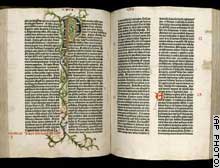World’s most valuable book on Internet
 AUSTIN, Texas (AP) — The University of Texas has put its entire two-volume Gutenberg Bible on the Internet, making it easier for scholars and the public to browse one of the world’s most valuable books.
AUSTIN, Texas (AP) — The University of Texas has put its entire two-volume Gutenberg Bible on the Internet, making it easier for scholars and the public to browse one of the world’s most valuable books.
Just as Johann Gutenberg made knowledge more accessible with the invention of the printing process, this digitization project continues that legacy,” said Richard Oram, head librarian at the university’s Harry Ransom Center, one of the world’s top cultural archives. The Ransom Center edition is not the first to go digital. Gutenberg Bibles in England and Japan already have been posted on the Internet and the Library of Congress has one available on CD-ROM, Oram said.
First major Western book
However, Ransom Center officials think their copy is the best of the lot, calling it the most-used version still in existence.
Gutenberg’s Bible revolutionized printing in Western civilization. Printed in Mainz, Germany, in the 1450s, the books were the first major Western book printed from movable type.
According to the Ransom Center, only about 200 were produced and only 48 copies exist today, each one of them unique since local artisans were hired to illuminate the letters opening each book.
The Ransom Center acquired its two-volume copy, which includes some illuminations in gold leaf, in 1978. Oram estimated the copy, which is 1,268 pages in two volumes, is worth up to $20 million.
CD-ROM coming
The Texas Gutenberg was used in monasteries in southern Germany as late as the 1760s. It was marked up by monks who scratched out some passages and corrected others. Other markings indicate which sections were to be read aloud or reserved for church services.
“Our copy is the most interesting in the world,” Oram said.
Needham said the online access, and the soon-to-be-developed high resolution CD-ROM, will be a boon to scholars who want to look at the Bible without traveling to Austin where it is enclosed in temperature-controlled glass and under the watch of 24-hour security.
Ransom Center staff began digitally scanning the Bible’s linen pages in June 2002. The finished project gives Web viewers 7,000 images and special software was used to allow for full visibility of the text and illuminations.






